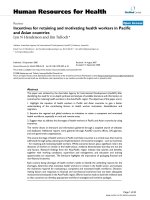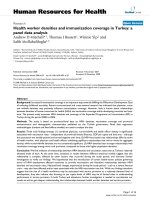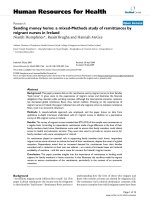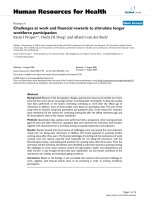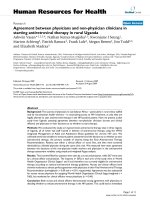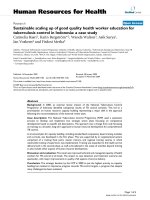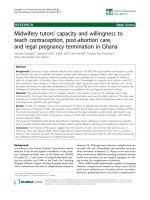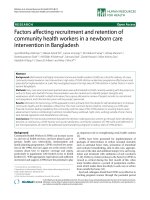Báo cáo sinh học: "Alpha-1 antitrypsin protein and gene therapies decrease autoimmunity and delay arthritis development in mouse model" potx
Bạn đang xem bản rút gọn của tài liệu. Xem và tải ngay bản đầy đủ của tài liệu tại đây (3.73 MB, 13 trang )
RESEARC H Open Access
Alpha-1 antitrypsin protein and gene therapies
decrease autoimmunity and delay arthritis
development in mouse model
Christian Grimstein
1†
, Young-Kook Choi
1†
, Clive H Wasserfall
2
, Minoru Satoh
2,3
, Mark A Atkinson
2
, Mark L Brantly
3
,
Martha Campbell-Thompson
2
, Sihong Song
1*
Abstract
Background: Alpha-1 antitrypsin (AAT) is a multi-functional protein that has anti-inflammatory and tissue
protective properties. We previously reported that human AAT (hAAT) gene therapy prevented autoimmune
diabetes in non-obese diabetic (NOD) mice and suppressed arthritis development in combination with doxycycline
in mice. In the present study we investigated the feasibility of hAAT monotherapy for the treatment of chronic
arthritis in collagen-induced arthritis (CIA), a mouse model of rheumatoid arthritis (RA).
Methods: DBA/1 mice were immunized with bovine type II collagen (bCII) to induce arthritis. These mice were
pretreated either with hAAT protein or with recombinant adeno-associated virus vector expressing hAAT (rAAV-
hAAT). Control groups received saline injections. Arthritis development was evaluated by prevalence of arthritis and
arthritic index. Serum levels of B-cell activating factor of the TNF-a family (BAFF), antibodies against both bovine
(bCII) and mouse collagen II (mCII) were tested by ELISA.
Results: Human AAT protein therapy as well as recombinant adeno-associated virus (rAAV8)-mediated hAAT gene
therapy significantly delayed onset and ameliorated disease development of arthritis in CIA mouse model.
Importantly, hAAT therapies significantly reduced serum levels of BAFF and autoantibodies against bCII and mCII,
suggesting that the effects are mediated via B-cells, at least partially.
Conclusion: These results present a new drug for arthritis therapy. Human AAT protein and gene therapies are
able to ameliorate and delay arthritis development and reduce autoimmunity, indicating promising potential of
these therapies as a new treatment strategy for RA.
Background
Rheumatoid arthritis (RA) is a systemic autoimmune
disease, characterized by chronic joint inflammation and
synovial hyperplasia leading to bone and joint destruc-
tion. The life expectancy is lowered and quality of life is
decreased in RA patients. So far little is kno wn about
the actual disease initiating stimulus; however, extensive
research over the last decades have shown that multiple
genetic as well as environmental factors interact and
trigger the onset of RA [1,2]. The autoimmune inflam-
mation of RA is maintained by inappropriate action of
macrophages, B-cells, T-cells, and other types of cell s
leading to dysregulated cytokine/chemokine producti on.
The synovial inflammation is caused by infiltration and
proliferation of activated immune cells including neutro-
phils, macrophages, fibroblasts, mast cells, NK cells,
NKT cells, T-cells as well as plasma cells [3]. Progres-
sive join t and bone destru ction is mediated through the
activities of osteoclasts, ch ondrocytes, synovial fibro-
blasts and cytokine induction of destructive enzymes,
chiefly matrix metalloproteinases (MMP) [4]. Current
therapy mainly aims to inhibit the biological function of
tumor necrosis factor-alpha (TNF-a ) and lymphocyte
proliferation. Due to ineffectiveness of anti-TNF-a ther-
apy in certain patients and various side effects of metho-
trexate which inhibits lymphocytes proliferation, there is
* Correspondence:
† Contributed equally
1
Department of Pharmaceutics, University of Florida, Gainesville, FL 32610,
USA
Full list of author information is available at the end of the article
Grimstein et al. Journal of Translational Medicine 2011, 9 :21
/>© 2011 Grimstein et al; licens ee BioMed Central Ltd. This is an Open Access article distr ibuted under the terms of the Creative
Commons Attribution License (http://c reativecommons.org/licenses/by/2.0), which permits unrestricted use, di stribution, and
reproduction in any medium, provided the original work is properly cit ed.
still the need to identify new target molecules/pathways
and to develop new treatment [5]. Immunoregulatory
and anti-inflammatory strategies that affect B-cell activa-
tion, T-cell activation or inhibit proinflammatory cyto-
kines have recently shown great potential for the
treatment of RA [5,6].
Human alpha-1 antitrypsin (hAAT) is a 52 kDa serum
glycoprotein, synthesized primarily in the liver. It is also
expressed in other types of cells including neutrophils,
monocytes, macrophages, alveolar macrophages, intest-
inal epithelial cells, carcinoma cells and t he cornea
[7-10]. The normal serum level of hAAT is 1-2mg/ml.
During inflammation, hAAT lev el, as an acute phase
reactant , can increase 3-4 folds, suggesting an important
role in responding to inflammation in the human body.
Increasing evidence indicates t hat hAAT is immunore-
gulatory, anti-inflammatory and may be used for the
treatment of RA. It inhibits neutrophil elastase and pro-
teinase 3 w ith high efficiency, as well as cathepsin G,
thrombin, trypsin and chymotrypsin with lower effi-
ciency [11]. Most of these proteases target receptor pro-
teins, involved in proinflammatory cytokine expression
and cell signali ng [12]. It also has been reported that
neutrophil elastase inhibitors reduce incidence as well as
severity of collagen-induced arthritis ( CIA) in both rats
and mice [13]. Human AAT is able to completely elimi-
nate the acute inflammatory infiltration and connective
tissue breakdown in the lung in a cigarette smoke-
induced emphysema mouse model [14]. It also inhibits
lipopolysaccharide (LPS)-stimulated release of TNF-a
and i nterleukin (IL) -1b, and enhances the production
of anti-inflammatory cytokine IL-10 [15-17]. Human
AAT signific antly protects against the lethality induced
by TNF-a or endotoxin in mice [18]. It can also induce
expression of IL1-Ra in human peripheral blood mono-
nuclear cells (PBMC’ s) [19] and reduces ischemia-
induced apoptosis and inflammation [20]. We have
recently shown, that combination therapy using doxycy-
cli ne and hAAT gene therapy reduces arthritis develop-
ment in mice, suggesting a therapeutic effe ct of hAAT
in an arthritis mouse model [21].
Recombinant adeno-associated virus vectors (rAAV)
have been widely used for gene therapy in animal mod-
els and human clinical trials [22], because of their
unique features in safety and efficiency. It has been
reported that rAAV mediated long-term and high levels
of transgene expression in a wide variety of tissues,
including muscle [23] , lung [24], liver [25], brain [26]
and eye [27]. Recently developed rAAV vectors includ-
ing new serotypes of AAV, mutants AAV and double
strandedAAVhaveprovidedmoreopportunitiesand
challenges for their application [28-31]. Previously, we
have shown hAAT gene therapy using rAAV2 and
rAAV1 vectors prevented type 1 diabetes. However, the
immune response to the transgene product (hAAT)
complicated the therapeutic effect [32,33]. We have
recently discovered that rAAV8 vector fail to transduce
dendritic cells and induce immune tolerance to trans-
gene product entailing rAAV8 as a promising vector
used for therapeutic intervention [34].
In the present study we further investigated the feasi-
bility of hAAT with its anti-inflammatory and immunor-
egulatory properties for the treatment of RA using both,
protein therapy and rAAV8 mediated gene therapy.
Methods
rAAV Vector Production
The rAAV-CB-hAAT vector construct was produced
and packaged a s previously described [27]. Briefly, this
vector carries hAAT cDNA driven by the cytomegalo-
virus (CMV) enhancer and chicken b- actin promoter
and contains AAV2 inverted terminal repeats (ITRs). It
was packaged into AAV serotype 8 capsid by cotransfec-
tion o f vector plasmid and helper plasmid (XYZ8) into
293 cells. rAAV8-CB-hAAT vectors were purified by
iodixanol gradient centrifugation followed by anion-
exchange chromatography. The physical particle titers of
vector preparations were assessed by dot blot analysis.
Animals
Six week-old male DBA/1 mice were purchased from
Harlan Sprague Dawley, Inc. (Indianapolis, IN), housed
in a specific pathogen-free room as approved by the
University of Florida Institutional Animal Care and Use
Committee. For induction of arthritis, bCII (Chondrex
LLC, Redmond , WA) was dissolved in 0.05N acetic acid
at a co ncentration of 2mg/ml by stirring overnight at
4°C a nd was emulsifi ed with an equal volum e of Com-
plete Freund’s Adjuvant (CFA) (Chondrex LLC, Red-
mond, WA). At the age of eight weeks, DBA/1 mice
were immunized intradermally at the base of the tail
with 0. 1ml of emulsion containing 100 μg of type II col-
lagen. Three weeks after priming (day 21), the mice
were boosted with 0.1 ml of bCII (100 μg) emulsified in
equal volume of incomplete Freund’ sAdjuvant(IFA)
(Difco, Detroit, MI). Fo r assessment of arthritis , all mice
were monitored three times a week by the same person
blinded to the treatment group and evaluated the inci-
dence of arthritis and clinical score. An arthritis score
system ranging from stage 0 - 4 was used: 0: no swelling
or redness; 1: detectable arthritis with erythema; 2: sig-
nificant swelling and redness; 3: severe swelling and red-
ness from joint to digit; 4: joint stiffness or deformity
with ankylosis [35]. The c linical score was expressed as
the average cumulative value of all four paws with a
maximum score per animal of 16. Severe arthritis was
defined as arthritis score > 3 for the purpose of compar-
ing data between groups.
Grimstein et al. Journal of Translational Medicine 2011, 9 :21
/>Page 2 of 13
Histological Assessment
For the analysis of arthritis, mice were anesthetized and
sacrificed by cervical dislocation on day 28 after immu-
nization. T he two hind limbs of mice in treatment and
control groups were removed. Specimens were fixed in
formalin and decalcified in RDO solution (Apex, Aurora,
IL) for 10-20 min depending on tissue size and then
checked manually for pliability. Sections 4 μmthick
were cut and stained with hematoxylin and eosin
according to standard methods.
Histological evaluation was performed by two inde-
pendent and blinded pathologists. Infiltration of immune
cells, hyperplasia, pannus formation and bone deforma-
tion was determined for each paw using an evaluation
scale ranging from 0-3 according to severity of pathohis-
tological changes. (0: normal, 1: mild, 2: moderate, 3:
severe).
Human AAT Protein and rAAV8-CB-AAT Vector
Administration
For hAAT protein therapy studies, DBA/1 mice were
intraperitoneally (IP) injected with 0.5 mg (in 100 μl sal-
ine) of hAAT (Prolastin
®
, Bayer Corp., Elkhard, IN).
The control group received saline injection. The injec-
tions were performed twice per week, starting at 6 days
before the first bCII immunization until the end of
study(EOS)atday70afterthefirstimmunization.For
hAAT gene therapy studies, DBA/1 mice were IP
injected with rAAV8-CB-hAAT vector (2 × 10
11
parti-
cles/mouse) two weeks beforethefirstCIIimmuniza-
tion. The control group received saline injection.
ELISA for the Detection of Serum hAAT and BAFF Levels
and Antibodies against hAAT, bCII and mCII
Detection of hAAT and anti-hAAT antibodies in mouse
serum was performed as previously described [32]. Puri-
fied hAAT (Athens Research & Technology, Athens,
GA) was used as a standard. Anti-type II collagen anti-
bodies in mouse serum were detected by a standard
ELISA. Briefly, microtiter plates (Immulon 4, Dynex
Technologies, C hantilly, VA) were coated with bCII or
mCII (0.5 μg/well, Chondrex LLC, Redmond, WA) in
Voller’s buffer overnight at 4°C. After blocking with 3%
bovine s erum albumin, wells were incubated with sam-
ples at room temp erat ure for 2 h. HRP-conjugat ed goat
anti-mouse IgG antibodies (1:1,000 dilution, Sigma,
St.Louis,MO),goatanti-mouseIgG1antibodies
(1:1,500 dilution, Roche, Indianapolis, IN) and goa t anti-
mouse IgG2a antibod ies (1:1,500 dilution, Roche, India-
napolis, IN) were incubated for 1 h at RT. The plates
were washed with PBS-Tween 20 between reactions.
After adding the substrate (o-phenylenediamine, Sigma,
St Louis, MO), plates were read at 490 nm on an MRX
microplate reader (Dynex Technologies, Chantilly, VA).
Optical densities were converted into un its based on a
standard curve generated with high titer sera from
DBA/1 mice immunized with bCII. Detection of BAFF
in serum was performed according to manufactures
instructions (R&D systems, Inc. Minneapolis, MN).
Cell Culture
The murine macrophage cell line RAW 264.7 was cul-
tured in serum free DMEM at 37°C in a 5% CO
2
incu-
bator. For measuring BAFF release into medium, cells
were seeded at 1 × 10
5
/ml in 12 well plates. Cells were
incuba ted in quadruplicates with hAAT (0.5mg/ml; Pro-
lastin
®
, Bayer Corp., Elkhard, IN) for 16 hours a nd
BAFF secretion into the culture medium was deter-
mined by ELISA according to manufactures instructions
(R&D systems, Inc. Minneapolis, MN).
Quantitative PCR
Total RNA from c ell culture described above, was iso-
lated using RNeasy Mini Kit (Quiagen, Valencia, CA).
Samples were processed according to the manufacture’s
protocol. For reverse transcription, cDNA was synthe-
sized with oligo dT
16
primers and Moloney Murine Leu-
kemiaVirusReverseTranscriptase(MMLV-RT)
according to manufacture’s manual (Taqman Reverse
Transcription Reagents, Applied Biosystems, Foster City,
CA).
cDNA was analyzed by quantitative PCR using gene-
specific primers with SYBR Green 2X PCR mix (Applied
Biosystems). The sequence of the primers were as fol-
lows: BAFF (205bp), sense: 5’-TGC CTT GGA GGA
GAA AGA GA-3’ and antisense: 5’ -GGA ATT GTT
GGG CAG TGT TT-3’; GAPDH (122bp), sense: 5’-CCT
GGA GAA ACC TGC CAA GTA T-3’ and antisense:
5’ -TG C TGT TGA AGT CGC AGG A-3’. Reactions
weresetupintriplicateandperformedontheABI
Prism 7700 Sequence Detector (Applied Biosystems).
The cycling parameters were 2 min at 95°C for dena-
turation, 40 cycles of 15s at 95°C and 30 s at 60°C for
amplification. The threshold cycle (C
T
)ofeachtarget
product was determined, set to the log linear range of
the amplification curve and kept constant for all data
analysis. Data were analyzed with Sequence Detector
Software (SDS). BAFF expression was normalized to the
corresponding GAPDH values for the respective treat-
men t. Values of BAFF expression following salin e treat-
ment are designated as 1. The experiment was repeated
twice.
Assessment of T-cell Autoreactive Response
To test the effect of AAV8-hAAT gene therapy on sple-
nocyte proliferation, spleens w ere harvested at 30 days
after the first bCII immunization. Splenocytes were iso-
lated and cultured in serum free X-VIVO medium
Grimstein et al. Journal of Translational Medicine 2011, 9 :21
/>Page 3 of 13
(Cambrex, Walkersville, MD) in the presence or absence
of bCII (100 μg/ml,ChondrexLLC,Redmond,WA).
After 3 days culture, 1 μCi/well of [
3
H] TdR was added.
Cells were cultured for additional 18h and [
3
H] TdR
uptake was measured using a b- scintillation counter.
To measure cytokine release into the cell culture
supernatant, a Beadlyte Mouse Multi-Cytokine Detec-
tion System 1 kit (Upstate, Temecula, CA, Cat #
48-005) was used according to the manufacture’ s
instruction and in conjunction with the Luminex 100
system for cytokine determination.
Statistical Analysis
Data Analysis was performed using GraphPad Prism 4.0
(GraphPad Software) and SAS (SAS Institute). Student’s
t-test was used to compare differences in BAFF levels in
culture medium as well as differences in mRNA expres-
sion levels. Mann-Whitney U-test was applied to analyze
differences in stimulation indices, cytokine levels, patho-
histological changes, serum levels of BAFF and antibo-
dies. For comparison of art hritis score, area under the
curv e analysis was used and differences in arthritis inci-
dence were determined using Kaplan-Meier survival
curve and log-rank test. A p-value of p ≤ 0.05 was con-
sidered statistically significant.
Results
Human AAT Protein Therapy Delayed Arthritis
Development in DBA/1 Mice
In order to investigate the effect of hAAT on develop-
ment of arthritis, we first examined the feasibility of
hAAT protein therapy in CIA mouse model. Administra-
tion of hAAT (0.5 mg/mouse twice per week, starting at
6 days before the induction of arthritis) result ed in sus-
tained high levels of hAAT in mouse serum (Figure 1A).
Although anti-hAAT-antibodies were detect ed (Figure
1B), serum levels of hAAT did not decrease over time.
A few days after the second immunization with bCII
(day 21), mice in control group developed arthritis in mul-
tiple joints, which was manifested by redness, severe joint
swelling and joint stiffness as well as ankylosis as the dis-
ease progressed. The severity of arthritis as measured by
the arthritic score rapidly increased in control group (n =
7) whereas the disease development in hAAT treatment
group (n = 9) was suppressed (Figure 1C). At day 49
(7 weeks) after the immunization, area under the curve
(AUC) in the hAAT group was 50.83 ± 21.64 (mean ±
SEM), while in control group it was 121.5 ± 17.67 (p =
0.029, mean ± SEM, AUC analysis until day 49) . Hu man
AAT protein therapy also reduced incidence of severe
arthritis (p = 0.0025, logrank tes t, Figure 1D). Moreover,
mice in hAAT treated group had significantly delayed
onset of arthritis compared with control group. On aver-
age, the clinical signs of severe arthritis (arthritis score
> 3) started on day 47.3 ± 8.7 (mean ± SD) in hAAT trea-
ted group compared to day 36.0 ± 5.8 (mean ± SD) in con-
trol group (p = 0.01 by students t-test). Although hAAT
treated mice also developed arthritis at the end (70 days
after the immunization) of the experiment, these results
showed that treatment of hAAT protein (Prolastin
®
)led
to a delayed arthritis onset and amelioration of disease
progression in CIA mouse model.
Human AAT Protein Therapy Reduced the Levels of anti-
bCII and anti-mCII Autoantibodies
It has been shown that high levels of serum anti-
collagen II au toantibodies are pathognomonic and asso-
ciated with the development of arthritis [36,37]. To t est
the effect of hAAT on autoantibody production, we
evaluated the levels of anti-CII autoantibodies in total
Ig, and IgG1 and IgG2a subclass at early (day 35) and
late (day 49) stages of the disease. As shown in Figure
2A, hAAT treatment did not result in a significant
change of total autoantibody levels against bCII (total
anti-bCII-Ig). However, hAAT treatment significantly
reduced the pathognomonic IgG2a (anti-bCII-IgG2a)
levels at day 35 (Figure 2B), and increased IgG1 (anti-
bCII-IgG1) levels a t day 49 (Figure 2C). Interestingly,
levels of total Ig autoantibodies against endogenous
mouse collagen II (total anti-mCII-Ig) were significantly
lower in hAAT protein treated group than those in con-
trol group (P < 0.05) (Figure 2D).
Human AAT (hAAT) Gene Therapy delayed Arthritis
Development
To furth er confirm our observation that hAAT is effec-
tive in delaying arthritis development, and to test the fea-
sibility of hAAT gene therapy for rheumatoid arthritis,
we used recombinant adeno-associated virus vector
(rAAV) to deliver the hAAT gene. A single IP injection
of rAAV8-CB-hAAT vector (2x10
11
particles/mouse, two
weeks before the first CII immunization) resulted in sus-
tained levels of hAAT in the circulation, similar to those
levels obtained following protein therapy (Figure 3A).
Interestingly, following AAV8 mediated gene delivery, we
did not observe the development of antibodie s to hAAT
which were detected during hAAT protein therapy (Fig-
ure 3B, compare vs. Figure 1B in mice w ith hAAT pro-
tein therapy). Similar to the results from hAAT protein
therapy, however, rAAV-mediated hAAT gene therapy
significantly reduced the prevalence of arthritis develop-
ment at the early stage of disease (Figure 3C). Area
underthecurve(AUC)inthegenetherapygroup(n=
10) was 71.65 ± 14.04 (mean ± SEM), while in control
group (n = 10) it was 123.20 ± 19.83 (mean ± SEM; p <
0.05 by AUC analysis until day 42). AAT gene therapy
also reduced the incidence of severe arthritis (score > 3)
at the early stage of disease (p = 0.035 by logrank test,
Grimstein et al. Journal of Translational Medicine 2011, 9 :21
/>Page 4 of 13
Figure 3D). Moreover, mice in hAAT gene therapy group
had significantly delayed onset of arthritis compared with
control group. On average, the clinical signs of severe
arthritis started on day 42.3 ± 7.5 (mean ± SD) in hAAT
gene therapy group compared to day 33.4 ± 7.3 in con-
trol group (mean ± SD; p < 0.02 by student’st-test).
These results indicate that similar to hAAT protein ther-
apy, AAV8 mediated h AAT gene delivery also delayed
arthritis onset and ameliorated early stage disease pro-
gression in CIA mouse model.
In an addi tional expe riment using AAV8 mediated
hAAT gene therapy, tissue protective properties of hAAT
were evaluated. Similar to the previous experiment, mice
in treatment group (n = 6) showed significantly reduced
arthritis development at the early disease stage compared
to control (n = 4) (Figure 4A, p < 0.05 by Mann-Whitney
U-test). As shown in Figure 4B-F, AAV8 mediated hAAT
gene therapy resulted in less infiltration of immune cells
into the joint cavity accompanied with reduced synovial
cell hyperplasia and pannus formation (p < 0.05 Mann-
Whitney U-test).
Human AAT (hAAT) Gene Therapy Reduced the Levels of
Anti-CII Autoantibodies
As shown in Figure 5, rAAV8-mediated hAAT gene
therapy resulted in a significant suppressio n of anti-CII
Figure 1 Antiarthritic effect of human alpha 1 antitrypsin (hAAT) in collagen induced arthritis (CIA) model. Human AAT (Prolastin
®
) was
intraperitoneally injected in DBA/1 mice (n = 9), twice per week starting 6 days before until day 70 after CII immunization. Control group
received saline injections (n = 7) (A) Serum hAAT protein levels in DBA/1 mice were measured by ELISA (mean+SD). ↓ indicates the day of first
hAAT injection. (B) Serum anti-hAAT antibody levels (anti-hAAT-IgG) in DBA/1 mice were measured by ELISA. Each dot represents antibody levels
(day 49 after bCII immunization, arbitrary units) of an individual mouse. (C) Arthritis score. For each paw, 0 is normal and 4 is the most severe
arthritis. The maximum score for each animal is 16. Each line represents the scores from hAAT treated group (open triangles, mean-SD) or
control group (open circles, mean+SD, *p = 0.029 by AUC analysis) (D) Incidence of severe arthritis is defined by arthritic score/mouse > 3
(**p = 0.0025 by logrank test). Dotted line, saline injected control group; Solid line, hAAT treated group.
Grimstein et al. Journal of Translational Medicine 2011, 9 :21
/>Page 5 of 13
autoantibody production. The levels of total Ig anti-bCII
(Figure 5A, top left panel) and IgG2a anti-bCII (Figure
5A, top right panel) were significantly reduced in hAAT
gene therapy group. Although IgG1 anti-bCII levels
(Figure 5A, bottom left panel) were also reduced in
hAAT gene therapy group, the ratio of IgG2a anti-bCII
to IgG1 anti-bCII (Figure 5A, bottom right panel) signif-
icantly decreased in hAAT gene therapy group. Impor-
tantly, hAAT gene therapy a lso reduced levels o f
autoantibodies against mCII and the ratio of IgG2a anti-
mCII to IgG1 anti-mCII (Figure 5B).
Human AAT Therapy Reduced B-cell Activating Factor
(BAFF) in vitro and in vivo
In order to further elucidate the underlying mechanism
of the anti-arthritic effect of hAAT, we performed addi-
tional studies focusing on the effect of AAT on T-cell
and B-cell activity. Since CIA is a T-cell-mediated auto-
immune disease, the effect of hAAT on T-cell function
was examined in a T-cell proliferation assay. As s hown
in Figure 6A, treatment of rAAV8-hAAT did not change
the antigen specific T-cell response after isolated spleno-
cytes were restimulated ex vivo with bCII. Similarly,
bCI I induced cytoki ne release (IFN-g, IL-4, IL-10, TNF-
a, IL-2) from isolated splenocytes did not show any sig-
nificant differences between treatment and control
group (Figure 6B). The effect of hAAT therapy on B-cell
activity was examined by determination o f serum levels
of B-cell activating factor of the TNF-a family (BAFF),
which has emerged as a crucial factor for B-cell expan-
sion and function. Interestingly, both hAAT protein as
well as AAV8 mediated hAAT gene therapy resulted in
significantly decreased serum levels of BAFF compared
to control group (Figure 6C, 6D). Since BAFF is mainly
Figure 2 Anti-collagen II (CII) antibody levels after hAAT treatment. Anti-CII antibodies at day 35 and day 49 were tested by ELISA. Closed
bars represent the average levels (n = 9, relative units, mean+SD) of antibodies in hAAT protein therapy treated group. Open bars represent the
average levels (n = 7, relative units, mean+SD) of antibodies in saline injected group. (A) Levels of total Ig antibodies to bCII (total anti-bCII-Ig).
(B) Levels of IgG2a anti-bCII (anti-bCII-IgG2a). (C) Levels of IgG1 anti-bCII (anti-bCII-IgG1). (D) Levels of total Ig antibodies to mCII (total anti-mCII-
Ig). * p < 0.05 by Mann-Whitney U- test.
Grimstein et al. Journal of Translational Medicine 2011, 9 :21
/>Page 6 of 13
secreted from monocytes and macrophages, we tested
the effect of hAAT on BAFF production in vitro.Mur-
ine macrophages (RAW264.7) were treated with hAAT.
Culture medium served as control. Protein secretion
into the culture medium was determined by ELISA and
mRNA expression was quantified by real-time PCR. As
shown in Figure 6E, BAFF levels in culture medium
were significantly lower in the AAT treated group than
those in the control group. Similarly, mRNA expressio n
levels of BAFF were also significantly decreased in AAT
treated group (Figure 6F). Together these results suggest
that the anti-arthritic effect of AAT is in part through
the inhibition of B-cell activation.
Discussion
RA is a complex systemic autoimmune disease
of unknown etiology. Although recently developed
biologics that target TNF-alpha have provided dramatic
improvement in controlling disease activity in many
patients, continued searches for more efficient and safer
treatments are still needed. In the present study we
showed that hAAT, administered as protein or through
rAAV8 mediated gene therapy, reduced levels of serum
anti-CII auto-a ntibodies and B-cell activating factor
(BAFF) and significantly delayed arthritis development in
a mouse model.
Although the exact mechanisms underlying the thera-
peutic effect remain to be further investigated, several
mechanisms may be involved. One is through the inhibi-
tion of proinflammatory cytokine production. It is well
known that various proinflammatory cytokines, includ-
ing TNF-a and IL1-b, play major roles in the pathogen-
esis of RA [3]. Strategies targeting these cytokines have
proven to be effective in treatment of RA [38]. Previous
work done by Janciauskiene and he r colleagues c learly
demonstrated that hAAT inhibited LPS-induced TNF-a,
Figure 3 Human AAT gene therapy delays disease progression in CIA mouse model. DBA/1 mice were intraperitoneally injected with
rAAV8-CB-hAAT vector (2 × 10
11
particles/mouse, n = 10) or saline (n = 10) two weeks before immunization with CII. Control group received
saline. Mice were sacrificed on day 56 (EOS). (A) Serum levels of hAAT. hAAT protein serum levels in vector injected group were measured by
ELISA (mean+SD). ↓ indicates the days of injection. (B) Anti-hAAT antibody levels. Serum anti-hAAT antibodies (anti-hAAT) were measured by
ELISA using samples obtained at 56 days after immunization. Anti-hAAT antibodies were undetectable in the vector injected group. Each dot
represents antibody level (arbitrary units) of an individual mouse. (C) Arthritis score. Each line represents the average score from hAAT treated
group (open triangles, mean-SD) or control group (open circles, mean+SD, * p < 0.05 as determined by AUC analysis.) (D) Incidence of severe
arthritis. Severe arthritis was defined by arthritic score > 3, (* p = 0.035 by logrank test.; 10 mice/group).
Grimstein et al. Journal of Translational Medicine 2011, 9 :21
/>Page 7 of 13
Figure 4 Tissue protective effect of hAAT gene therapy in CI A mouse model. DBA/1 mice were intraperitoneally injected with rAAV8-CB -
hAAT vector (2 × 10
11
particles/mouse, n = 6) or saline (n = 4) two weeks before immunization with CII. Control group received saline. (A)
Arthritis development was evaluated based on arthritis score (mean + SD). Open circle represent rAAV8-CB-hAAT vector injected group, open
triangle represent control group. Mice were sacrificed on day 28 after CII immunization, hind limbs were harvested and processed for histological
assessment. *p < 0.05 by Mann-Whitney U-test. (B) Histopathological evaluation of arthritis development. Mice in gene therapy group (black
bars) or control group (empty bars) were evaluated according to histopathological changes by two blinded pathologists. Each hind paw was
evaluated based on a scale ranging from 0-3. (mean+SD). *p < 0.05, **p < 0.01 by Mann-Whitney U-test. (INF: Infiltration of Immune Cells, HYP:
Hyperplasia, P.F.: Pannus Formation, B.D.: Bone Destruction) (C,D) Representative joint section from mice receiving hAAT gene therapy. (E,F)
Representative joint section from mice in control group (saline injection). Magnification: C,E: 100x; D,F: 200x.
Grimstein et al. Journal of Translational Medicine 2011, 9 :21
/>Page 8 of 13
Figure 5 Effe ct of hAAT gene therapy on auto-antibody production. Anti-CII antibodies at day 28, 42 and 56 were tested by ELISA. Black
bars represent the average levels (n = 10, mean+SD) (relative units) of antibodies in hAAT gene therapy treated group. Open bars represent the
average levels (n = 10, relative units, mean+SD) of antibodies in saline injected group. (A) Antibody levels against bovine CII (bCII). Top left panel,
total Ig antibodies against bCII (total anti-bCII-Ig); Top right panel, levels of IgG2a anti-bCII (anti-bCII-IgG2a); Bottom left panel, levels of IgG1 anti-
bCII (anti-bCII-IgG1); Bottom right panel, the ratio of anti-bCII-IgG2a to anti-bCII-IgG1 (anti-bCII-IgG2a/IgG1 ratio). (B) Antibody levels against
mouse CII (mCII). Top left panel, total Ig antibodies against mCII (total anti-mCII-Ig); Top right panel, levels of IgG2a anti-mCII (anti-mCII-IgG2a);
Bottom left panel, levels of IgG1 anti-mCII (anti-mCII-IgG1); Bottom right panel, the ratio of anti-mCII-IgG2a to anti-mCII-IgG1 (anti-mCII-IgG2a/
IgG1). *p < 0.05, **p < 0.01, ***p < 0.001 by Mann-Whitney U- test.
Grimstein et al. Journal of Translational Medicine 2011, 9 :21
/>Page 9 of 13
Figure 6 Effects of hAAT therapy on T-cells and B-cells. (A) Proliferative response of splenocytes after stimulation with bovine type II
collagen (bCII, 10 μg/ml). Splenocytes (4 × 10
5
cells/well, in 96-well plate) were isolated on day 28 after rAAV8-hAAT injection. Black bar, AAT
gene therapy group (n = 6); open bar, control group (n = 4). Data are expressed as the stimulation index, determined by calculating the ratio of
cell proliferation with antigen (measured in counts per minute, cpm) relative to that with medium alone (mean+SD). (B) Cytokine production
from bCII-stimulated (100 μg/ml) splenocytes. Values are the mean+SD of each group (n = 6 for rAAV8-hAAT group, black bars; n = 4 for saline
group, open bars). (C) Serum level of BAFF in hAAT treated mice (black bar, n = 9, day 35) and control mice (open bar, n = 7). Data is expressed
as mean+SD. (D) BAFF serum level in rAAV8-hAAT treated mice (black bar, n = 10, day 28) and control (open bar, n = 10). In vitro effect of hAAT
on (E) BAFF secretion into culture medium measured by ELISA and (F) BAFF gene expression determined by real-time PCR. Murine macrophages
(RAW 264.7) were treated with hAAT (0.5mg/ml, black bar). Culture medium served as control (open bar). Both experiments were performed in
quadruplicates and repeated twice. Data is expressed as mean+SD. *p < 0.05, **p < 0.01.
Grimstein et al. Journal of Translational Medicine 2011, 9 :21
/>Page 10 of 13
IL-6 and IL-1b production by human monocytes [15,16].
In addition, hAAT completely suppressed macrophage
inflammatory protein-2 (MIP-2)/monocyte chemotactic
protein-1 (MCP-1) gene expression in lung [39]. Human
AAT also enhanced anti-inflammatory cytokine IL-10
production from monocytes [ 15]. As a consequence of
interfering with the cytokine/chemokine network, hAAT
may also inhibit polymorphonuclear leukocyte (PMN)
invasion into the joint. Churg et al. demonstrated that
hAAT inhibited silica-induced PMN influx into the lung
and partially suppressed nuclear transcription factor B
(NF-B) translocation and increased inhibitor of NF-B
(I-B) levels in a mouse model of acute PMN mediated
inflammation [39]. Thus, it is possible that the effects
of hAAT on pro-inflammatory cytokine production
contribute to suppression of autoimmune-mediated
inflammation.
In previous studies we showed that hAAT reduced
anti-insulin auto-antibodies (IAA) and attenuated cell-
mediated autoimmunity [32,33]. Consistent with these
results, the present study showed that hAAT reduced
the levels of anti-CII auto-antibodies and the IgG2a/
IgG1 ratios of anti-CII auto-antibodies (mCII and bCII).
We have observed that the effect of hAAT to suppres s
arthritis development is more profound in early stage of
arthritis development. This is supported by the effect of
hAAT on pathognomonic IgG2a antibody development
at early time points (Fig.2) as well as the observation
that mice eventually develop arthritis overtime. There-
fore, hAAT maybe especially suitable for combination
therapies. We did not observe significant effect of AAT
on T-cell proliferation and cytokine production in vitro
(Figure 6A and 6B) indicating that AAT may have lim-
ited direct effect on T-cells. These data also suggest that
AAT may more directly affect B-cell activity. Indeed, we
have shown that AAT therapies significantly reduced
B-cell activating factor of the TNF-a family (BAFF)
in vitro and in vivo. BAFF is an important factor that
modulates B-cell tolerance and homeostasis. It has been
shown that soluble BAFF is elevated in serum and target
organs of CIA model [40] and BAFF antagonists sup-
pressed arthritis development in murine models of rheu-
matoid arthritis [41]. In addition, increased BAFF levels
were found in serum of RA patients which correlated
with serum levels of rheumatoid factor [42]. The exact
mechanism that AAT suppresses BAFF production
remains to be elucidated.
Another possible mechanism of hAAT suppressing
arthritis development is through inhibition of protei-
nases to prevent tissue inju ry and joint destruction.
Human AAT is well know n as a serine proteinase inhi-
bitor (serpin). It inhibits proteinase 3, neutrophil elas-
tase, and cathepsin G. These serine proteases are
released by joint invading neutrophils following
inflammatory stimuli and have shown to be involved in
arthritis development [12,13,43,44]. Human AAT can
also reduce ischemia-induced apoptosis, inflammation,
and acute phase response in the kidney [20]. We have
recently shown that hAAT directly inhibits caspase 3
activity and protects islet cells from cytokine and chemi-
cally-induced apoptosis [45].
In the protein therapy studies, we used Prolastin
®
,
which is clinical grade hAAT purified from human
plasma. Repeated IP injection of hAAT induced strong
humoral immune response against hAAT in DBA/1
mice (Figure 1B), similar to what has been observed in
previous studies [46,47]. It is possible that non-specific
inflammation caused by repeated IP injection is respon-
sible fo r inhibition of arthritis. In order to rule ou t this
possibility, we performed rAAV8 mediated hAAT gene
therapy. AAV serotype 8 vector is unique for this pur-
pose because it can mediate long term and high levels
of transgene expression in the liver and muscle, but is
not able to transduce dendritic cells and has low immu-
nogenicity [48,49]. Indeed,afterasingleinjectionof
rAAV8-CB-hAAT vector, sustained high levels of hAAT
were detected in the circulation, while no detectable
levels of anti-hAAT antibodies were present (Figure 3B)
in contrast to mice that received hAAT protein therapy.
These results are consistent with our recent observa-
tions in NOD mice and imply new applications of
rAAV8 vectors [34]. The detailed mechanism that
rAAV8 vector mediates no immune response to the
transgene product remains elusive. Importantly, we have
observed protective effects and reductions of auto-
antibodies by hAAT gene therapy. These results strongly
support our hypothesis that hAAT is able to reduce
inflammation in autoimmune diseases, such as RA and
type 1 diabetes.
Conclusion
Our results from protein and gene therapy showed that
hAAT is effective in delaying arthritis development in a
mouse model of CIA. They indicate that hAAT has
immunoregulatory and immunomodulatory effects and
has great potential as a new treatment for RA. We also
have shown that rAAV8 mediate d gene t herapy resulted
in a reduced immune response to the transgene product.
Future studies will focus on improvement of the thera-
peutic effect by optimizing the dose and timing of
hAAT or rAAV8 vector delivery, and by combination
therapy with other anti-arthritic drugs.
Abbreviations
hAAT: human Alpha-1 Antitrypsin; CIA: Collagen Induced Arthritis; IFA:
Incomplete Freund’s Adjuvant; CFA: Complete Freund’s Adjuvant; RA:
Rheumatoid Arthritis; NOD: Non Obese Diabetic; bCII: bovine type II
Collagen; mCII: mouse type II Collagen; TNF-α: Tumor Necrosis Factor-alpha;
Grimstein et al. Journal of Translational Medicine 2011, 9 :21
/>Page 11 of 13
IL: Interleukin; LPS: Lipopolysaccharide; PBMC: Peripheral Blood Mononuclear
Cells; BAFF: B-cell Activation Factor of the TNF-α Family; rAAV: Recombinant
Adeno-Associated Virus; MMP: Matrix- Metalloproteinase; ELISA: Enzyme-
Linked Immunosorbent Assay
Acknowledgements
This work was supported by grants from NIH (DK58327) and University of
Florida Office of Research.
Author details
1
Department of Pharmaceutics, University of Florida, Gainesville, FL 32610,
USA.
2
Department of Pathology, University of Florida, Gainesville, FL 32610,
USA.
3
Department of Medicine, University of Florida, Gainesville, FL 32610,
USA.
Authors’ contributions
CG conceived of the study, participated in its design, carried out animal
experiments, cell proliferation assay, immunoassays, performed statistical
analysis and drafted the manuscript. YKC conceived of the study,
participated in its design and performed animal experiments and cell
proliferation assay. CW helped performing cell proliferation assay, MS
participated in discussion and helped to revise the manuscript, MA, MCT
and MB participated in design and discussion of the study, SS conceived of
the study participated in its design and helped to revise the manuscript. All
authors read and approved the final manuscript.
Competing interests
Christian Grimstein and Sihong Song may be entitled to future patent
royalties from technology described in this paper.
Received: 4 October 2010 Accepted: 24 February 2011
Published: 24 February 2011
References
1. Firestein GS: Evolving concepts of rheumatoid arthritis. Nature 2003,
423:356-361.
2. Edwards CJ, Cooper C: Early environmental factors and rheumatoid
arthritis. Clin Exp Immunol 2006, 143:1-5.
3. McInnes IB, Schett G: Cytokines in the pathogenesis of rheumatoid
arthritis. Nat Rev Immunol 2007, 7:429-442.
4. Muller-Ladner U, Pap T, Gay RE, Neidhart M, Gay S: Mechanisms of disease:
the molecular and cellular basis of joint destruction in rheumatoid
arthritis. Nat Clin Pract Rheumatol 2005, 1:102-110.
5. Smolen JS, Aletaha D, Koeller M, Weisman MH, Emery P: New therapies for
treatment of rheumatoid arthritis. Lancet 2007, 370:1861-1874.
6. Groh V, Bruhl A, El-Gabalawy H, Nelson JL, Spies T: Stimulation of T cell
autoreactivity by anomalous expression of NKG2D and its MIC ligands in
rheumatoid arthritis. Proc Natl Acad Sci USA 2003, 100:9452-9457.
7. Boskovic G, Twining SS: Local control of alpha1-proteinase inhibitor
levels: regulation of alpha1-proteinase inhibitor in the human cornea by
growth factors and cytokines. Biochim Biophys Acta 1998, 1403:37-46.
8. Geboes K, Ray MB, Rutgeerts P, Callea F, Desmet VJ, Vantrappen G:
Morphological identification of alpha-I-antitrypsin in the human small
intestine. Histopathology 1982, 6:55-60.
9. Keppler D, Markert M, Carnal B, Berdoz J, Bamat J, Sordat B: Human colon
carcinoma cells synthesize and secrete alpha 1-proteinase inhibitor. Biol
Chem Hoppe Seyler 1996, 377:301-311.
10. Ray MB, Desmet VJ, Gepts W: alpha-1-Antitrypsin immunoreactivity in
islet cells of adult human pancreas. Cell Tissue Res 1977, 185:63-68.
11. Macen JL, Upton C, Nation N, McFadden G: SERP1, a serine proteinase
inhibitor encoded by myxoma virus, is a secreted glycoprotein that
interferes with inflammation. Virology 1993, 195:348-363.
12. Adkison AM, Raptis SZ, Kelley DG, Pham CT: Dipeptidyl peptidase I
activates neutrophil-derived serine proteases and regulates the
development of acute experimental arthritis. J Clin Invest 2002,
109:363-371.
13. Kakimoto K, Matsukawa A, Yoshinaga M, Nakamura H: Suppressive effect of
a neutrophil elastase inhibitor on the development of collagen-induced
arthritis. Cell Immunol 1995, 165:26-32.
14. Dhami R, Gilks B, Xie C, Zay K, Wright JL, Churg A: Acute cigarette smoke-
induced connective tissue breakdown is mediated by neutrophils and
prevented by alpha1-antitrypsin. Am J Respir Cell Mol Biol 2000,
22:244-252.
15. Janciauskiene S, Larsson S, Larsson P, Virtala R, Jansson L, Stevens T:
Inhibition of lipopolysaccharide-mediated human monocyte activation,
in vitro, by alpha1-antitrypsin. Biochem
Biophys Res Commun 2004,
321:592-600.
16. Janciauskiene SM, Nita IM, Stevens T: Alpha1-antitrypsin, old dog, new
tricks. Alpha1-antitrypsin exerts in vitro anti-inflammatory activity in
human monocytes by elevating cAMP. J Biol Chem 2007, 282:8573-8582.
17. Nita I, Hollander C, Westin U, Janciauskiene SM: Prolastin, a pharmaceutical
preparation of purified human alpha1-antitrypsin, blocks endotoxin-
mediated cytokine release. Respir Res 2005, 6:12.
18. Libert C, Van Molle W, Brouckaert P, Fiers W: alpha1-Antitrypsin inhibits
the lethal response to TNF in mice. J Immunol 1996, 157:5126-5129.
19. Tilg H, Vannier E, Vachino G, Dinarello CA, Mier JW: Antiinflammatory
properties of hepatic acute phase proteins: preferential induction of
interleukin 1 (IL-1) receptor antagonist over IL-1 beta synthesis by human
peripheral blood mononuclear cells. J Exp Med 1993, 178:1629-1636.
20. Daemen MA, Heemskerk VH, van’t Veer C, Denecker G, Wolfs TG,
Vandenabeele P, Buurman WA: Functional protection by acute phase
proteins alpha(1)-acid glycoprotein and alpha(1)-antitrypsin against
ischemia/reperfusion injury by preventing apoptosis and inflammation.
Circulation 2000, 102:1420-1426.
21. Grimstein C, Choi YK, Satoh M, Lu Y, Wang X, Campbell-Thompson M,
Song S: Combination of alpha-1 antitrypsin and doxycycline suppresses
collagen-induced arthritis. J Gene Med 12:35-44.
22. Zaiss AK, Muruve DA: Immunity to adeno-associated virus vectors in
animals and humans: a continued challenge. Gene Ther 2008, 15:808-816.
23. Song S, Morgan M, Ellis T, Poirier A, Chesnut K, Wang J, Brantly M,
Muzyczka N, Byrne BJ, Atkinson M, Flotte TR: Sustained secretion of
human alpha-1-antitrypsin from murine muscle transduced with adeno-
associated virus vectors. Proc Natl Acad Sci USA 1998, 95:14384-14388.
24. Flotte TR, Afione SA, Conrad C, McGrath SA, Solow R, Oka H, Zeitlin PL,
Guggino WB, Carter BJ: Stable in vivo expression of the cystic fibrosis
transmembrane conductance regulator with an adeno-associated virus
vector. Proc Natl Acad Sci USA 1993, 90:10613-10617.
25. Xu L, Daly T, Gao C, Flotte TR, Song S, Byrne BJ, Sands MS, Parker Ponder K:
CMV-beta-actin promoter directs higher expression from an adeno-
associated viral vector in the liver than the cytomegalovirus or
elongation factor 1 alpha promoter and results in therapeutic levels of
human factor × in mice. Hum Gene Ther 2001, 12:563-573.
26. Kaplitt MG, Leone P, Samulski RJ, Xiao X, Pfaff DW, O’Malley KL, During MJ:
Long-term gene expression and phenotypic correction using adeno-
associated virus vectors in the mammalian brain. Nat Genet 1994,
8:148-154.
27. Flannery JG, Zolotukhin S, Vaquero MI, LaVail MM, Muzyczka N,
Hauswirth WW: Efficient photoreceptor-targeted gene expression in vivo
by recombinant adeno-associated virus. Proc Natl Acad Sci USA 1997,
94:6916-6921.
28. Gao GP, Alvira MR, Wang L, Calcedo R, Johnston J, Wilson JM: Novel
adeno-associated viruses from rhesus monkeys as vectors for human
gene
therapy. Proc Natl Acad Sci USA 2002, 99:11854-11859.
29. Wu Z, Asokan A, Samulski RJ: Adeno-associated virus serotypes: vector
toolkit for human gene therapy. Mol Ther 2006, 14:316-327.
30. Zhong L, Li B, Mah CS, Govindasamy L, Agbandje-McKenna M, Cooper M,
Herzog RW, Zolotukhin I, Warrington KH Jr, Weigel-Van Aken KA, et al: Next
generation of adeno-associated virus 2 vectors: point mutations in
tyrosines lead to high-efficiency transduction at lower doses. Proc Natl
Acad Sci USA 2008, 105:7827-7832.
31. McCarty DM, Monahan PE, Samulski RJ: Self-complementary recombinant
adeno-associated virus (scAAV) vectors promote efficient transduction
independently of DNA synthesis. Gene Ther 2001, 8:1248-1254.
32. Song S, Goudy K, Campbell-Thompson M, Wasserfall C, Scott-Jorgensen M,
Wang J, Tang Q, Crawford JM, Ellis TM, Atkinson MA, Flotte TR:
Recombinant adeno-associated virus-mediated alpha-1 antitrypsin gene
therapy prevents type I diabetes in NOD mice. Gene Ther 2004,
11:181-186.
33. Lu Y, Tang M, Wasserfall C, Kou Z, Campbell-Thompson M, Gardemann T,
Crawford J, Atkinson M, Song S: Alpha1-antitrypsin gene therapy
modulates cellular immunity and efficiently prevents type 1 diabetes in
nonobese diabetic mice. Hum Gene Ther 2006, 17:625-634.
Grimstein et al. Journal of Translational Medicine 2011, 9 :21
/>Page 12 of 13
34. Lu Y, Song S: Distinct immune responses to transgene products from
rAAV1 and rAAV8 vectors. Proc Natl Acad Sci USA 2009, 106:17158-17162.
35. Kim SH, Kim S, Evans CH, Ghivizzani SC, Oligino T, Robbins PD: Effective
treatment of established murine collagen-induced arthritis by systemic
administration of dendritic cells genetically modified to express IL-4.
J Immunol 2001, 166:3499-3505.
36. Seki N, Sudo Y, Yoshioka T, Sugihara S, Fujitsu T, Sakuma S, Ogawa T,
Hamaoka T, Senoh H, Fujiwara H: Type II collagen-induced murine
arthritis. I. Induction and perpetuation of arthritis require synergy
between humoral and cell-mediated immunity. J Immunol 1988,
140:1477-1484.
37. Taylor PC, Plater-Zyberk C, Maini RN: The role of the B cells in the
adoptive transfer of collagen-induced arthritis from DBA/1 (H-2q) to
SCID (H-2d) mice. Eur J Immunol 1995, 25:763-769.
38. Olsen NJ, Stein CM: New drugs for rheumatoid arthritis. N Engl J Med
2004, 350:2167-2179.
39. Churg A, Dai J, Zay K, Karsan A, Hendricks R, Yee C, Martin R, MacKenzie R,
Xie C, Zhang L, et al: Alpha-1-antitrypsin and a broad spectrum
metalloprotease inhibitor, RS113456, have similar acute anti-
inflammatory effects. Lab Invest 2001, 81:1119-1131.
40. Zhang M, Ko KH, Lam QL, Lo CK, Srivastava G, Zheng B, Lau YL, Lu L:
Expression and function of TNF family member B cell-activating factor in
the development of autoimmune arthritis. Int Immunol 2005,
17:1081-1092.
41. Wang H, Marsters SA, Baker T, Chan B, Lee WP, Fu L, Tumas D, Yan M,
Dixit VM, Ashkenazi A, Grewal IS: TACI-ligand interactions are required for
T cell activation and collagen-induced arthritis in mice. Nat Immunol
2001, 2:632-637.
42. Pers JO, Daridon C, Devauchelle V, Jousse S, Saraux A, Jamin C, Youinou P:
BAFF overexpression is associated with autoantibody production in
autoimmune diseases. Ann N Y Acad Sci 2005, 1050:34-39.
43. Milner JM, Patel A, Rowan AD: Emerging roles of serine proteinases in
tissue turnover in arthritis. Arthritis Rheum 2008, 58:3644-3656.
44. Miyata J, Tani K, Sato K, Otsuka S, Urata T, Lkhagvaa B, Furukawa C, Sano N,
Sone S: Cathepsin G: the significance in rheumatoid arthritis as a
monocyte chemoattractant. Rheumatol Int 2007, 27:375-382.
45. Zhang B, Lu Y, Campbell-Thompson M, Spencer T, Wasserfall C, Atkinson M,
Song S: Alpha1-antitrypsin protects beta-cells from apoptosis. Diabetes
2007, 56:1316-1323.
46. Ma H, Lu Y, Li H, Campbell-Thompson M, Parker M, Wasserfall C, Haller M,
Brantly M, Schatz D, Atkinson M, Song S: Intradermal alpha1-antitrypsin
therapy avoids fatal anaphylaxis, prevents type 1 diabetes and reverses
hyperglycaemia in the NOD mouse model of the disease. Diabetologia
53:2198-2204.
47. Lu Y, Parker M, Pileggi A, Zhang B, Choi YK, Molano RD, Wasserfall C,
Ricordi C, Inverardi L, Brantly M, et al: Human alpha 1-antitrypsin therapy
induces fatal anaphylaxis in non-obese diabetic mice.
Clin Exp Immunol
2008, 154:15-21.
48. Vandenberghe LH, Wang L, Somanathan S, Zhi Y, Figueredo J, Calcedo R,
Sanmiguel J, Desai RA, Chen CS, Johnston J, et al: Heparin binding directs
activation of T cells against adeno-associated virus serotype 2 capsid.
Nat Med 2006, 12:967-971.
49. Xin KQ, Mizukami H, Urabe M, Toda Y, Shinoda K, Yoshida A, Oomura K,
Kojima Y, Ichino M, Klinman D, et al: Induction of robust immune
responses against human immunodeficiency virus is supported by the
inherent tropism of adeno-associated virus type 5 for dendritic cells.
J Virol 2006, 80:11899-11910.
doi:10.1186/1479-5876-9-21
Cite this article as: Grimstein et al.: Alpha-1 antitrypsin protein and gene
therapies decrease autoimmunity and delay arthritis development in
mouse model. Journal of Translational Medicine 2011 9:21.
Submit your next manuscript to BioMed Central
and take full advantage of:
• Convenient online submission
• Thorough peer review
• No space constraints or color figure charges
• Immediate publication on acceptance
• Inclusion in PubMed, CAS, Scopus and Google Scholar
• Research which is freely available for redistribution
Submit your manuscript at
www.biomedcentral.com/submit
Grimstein et al. Journal of Translational Medicine 2011, 9 :21
/>Page 13 of 13

